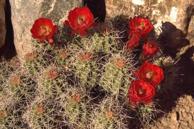

Common Names: Hedgehog
Cactus, Claret Cup Cactus, King's Cup Cactus, Mound Cactus
Genus: Echinocereus
Species: triglochidiatus
Parts Used: pulp, flowers and stems

There are many different kinds of hedgehog cacti. The Crimson hedgehog cactus is a small barrel shaped cactus that grows in clumps of a few to a hundred stems. The stems are cylindrical in shape and are up to 1 foot long and 1 to 2 1/2 inches thick. There are about 9 or 10 ribs on the stem. This cactus has no leaves and has chlorophyll in the stems. The stems of this Crimson hedgehog are shorter and more tightly packed together than other hedgehog cacti.
Echinocerens comes from the Greek word for hedgehog, echinos. Early settlers thought the spines of the cactus made it look like a hedgehog. Triglochidialus means "three barbed bristles". The hedgehog cactus has clusters of three spines along its ribs. Each spine can be 2 to 3 inches long.
The flowers are a beautiful deep red, with many petals that form the shape of a cup. The fruits are red, and edible. The flowers bloom from April through June, and are the first to bloom in the desert. Unlike other cacti, they stay open at night, and bloom for about 3 to 5 days. This species is the only red-flowered hedgehog. They also have pink or lavender anthers.
Not only are the flowers open at night, but so are the plant's pores, or stomata. They use the cool night temperatures to exchange oxygen and carbon dioxide. During the day the plants do their photosynthesis, but they keep their stomata closed so they won't lose any moisture.
Some Native Americans collect the flowers stems, burn off the spines and mash them. Sugar is added and then it is baked to make sweet cakes.
The plants grow in middle elevations of deserts and mountain deserts. They often grow against rocky outcroppings. They can grow in colder climates because the stems clump so closely together. This reduces surface area through which it can lose heat. It can grow in elevations from 3,020 to 7,915 feet. This plant is native to the American continent.
2001
Bibliography:
"Echinocereus riglochidiatus", http://www.fs.fed.us/database/feis/plants/cactus/echtri/, (July 2000).
" Desert Plants" http://www.desertusa.com, (June 2000.)